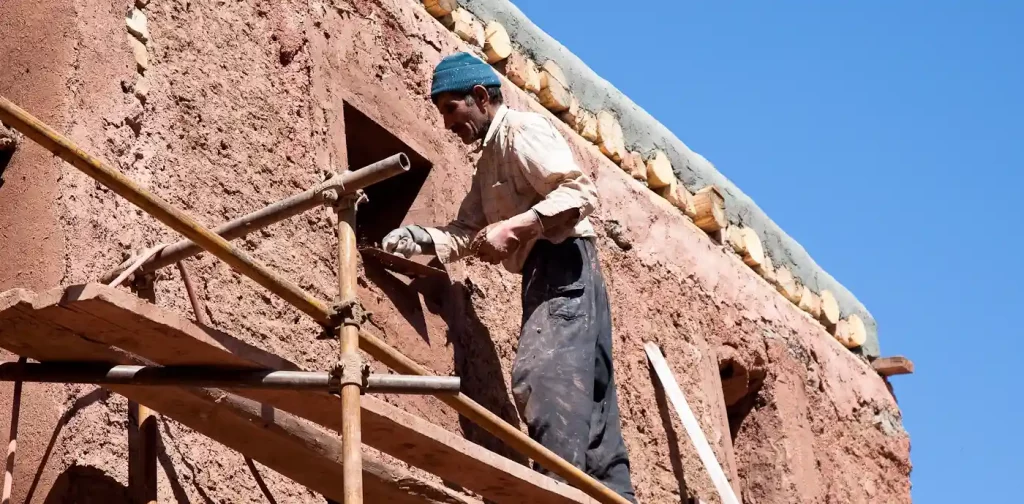Mainstreaming Low-Carbon Construction Through Ancient Practices

Photo: Erwin Bolwidt on Flickr
As one of our primary needs, shelter has been crucial for humans since ancient times. Then, as populations increase and demand for housing and the built environment grows, construction technologies advance. Unfortunately, this development comes with exploitation of natural resources and a large carbon footprint. In light of this, Mason Ink utilizes heritage and ancient practices to minimize environmental impact and champion low-carbon construction in India.
The Expense of Buildings
Constructing a building is like creating and completing a giant puzzle, from sketching blueprints to bringing everything together in the construction phase to having it ready for its purpose. However, this puzzle may have harmful consequences for our planet. Construction requires resource-intensive materials such as concrete, cement, steel, aluminum, and others. Making these materials involves processes that demand significant energy and extraction of natural resources.
Furthermore, from the use of fossil fuel in construction machineries to the daily use of the building itself, energy is used extensively. Buildings demand energy for heating, cooling, and electricity, and sometimes designs lack the consideration for energy efficiency, often due to limited awareness and differing priorities.
According to the International Energy Agency, buildings’ operations contribute to 30% of global final energy use and 26% of energy-related emissions worldwide. This includes 8% from direct emissions within buildings and 18% from the production of electricity and heat used in buildings.
Therefore, these modern yet conventional building construction practices, which emit significant pollutions and carbon emissions, may result in far-reaching environmental consequences. Thus, an alternative approach to reduce the carbon footprint of a building is needed.
Ancient Practice of Mud Construction in India
The age-old practice of utilizing abundant mud widely found around the world could offer a viable alternative for replacing certain materials. Throughout history, mud has been a common choice for constructing shelters and even for creating enduring architectural wonders that have stood strong for centuries.
In India, women architects are reviving the local ancient practice of mud building in their work. In rural villages, Rosie Paul and Sridevi Changali are championing the use of mud as building construction material. Through their company, Mason Ink, local residents process readily available mud into bricks for construction within the village, benefiting locals from this practice instead of profiting large manufacturers.
Combining various techniques in their work, local brick makers often combine mud with cow dung, sand waste, and lime. This mixture creates a durable and weather-resistant material suitable for construction. To its advantage, mud prevents mold growth by allowing airflow and releases day heats absorbed at night, reducing the need for intensive air conditioning.
Mud houses are a longstanding tradition in India that is deeply ingrained in the country’s heritage. With proper knowledge and understanding, this practice could be revived at scale to minimize the environmental impact of buildings and slowly replace the current conventional methods.
Joint Initiative for Low-Carbon Buildings
Reintroducing ancient practices and sustainably utilizing natural resources require multidisciplinary technical knowledge and expertise. It’s also important to recognize that each region has distinct characteristics, and low-carbon construction practices should be tailored to fit the available resources of the region.Ultimately, shared awareness among stakeholders is important in achieving environmental sustainability. Architects, engineers, manufacturers, and public policymakers should collaborate and prioritize low-carbon options in their business practices. By integrating heritage and modern engineering, sustainable building can be effectively mainstreamed to lessen the environmental impact of our built environment.
Editor: Nazalea Kusuma

Join Green Network Asia Membership
Amidst today’s increasingly complex global challenges, equipping yourself, team, and communities with interdisciplinary and cross-sectoral insights on sustainability-related issues and sustainable development is no longer optional — it is a strategic necessity to stay ahead and stay relevant.
Join Now

 Weaving the Thread Between the Last Elephant and the Floods in Sumatra
Weaving the Thread Between the Last Elephant and the Floods in Sumatra  Bringing Buried Rivers Back to Life Through Daylighting
Bringing Buried Rivers Back to Life Through Daylighting  Prescribing Beyond Profit for CEOs’ Anxiety
Prescribing Beyond Profit for CEOs’ Anxiety  An Interview with May Tan-Mullins, CEO and Provost of University of Reading Malaysia
An Interview with May Tan-Mullins, CEO and Provost of University of Reading Malaysia  An Interview with Eu Chin Fen, CEO of Frasers Hospitality
An Interview with Eu Chin Fen, CEO of Frasers Hospitality  The UK Government’s Funding Package Plan to Tackle Youth Unemployment
The UK Government’s Funding Package Plan to Tackle Youth Unemployment